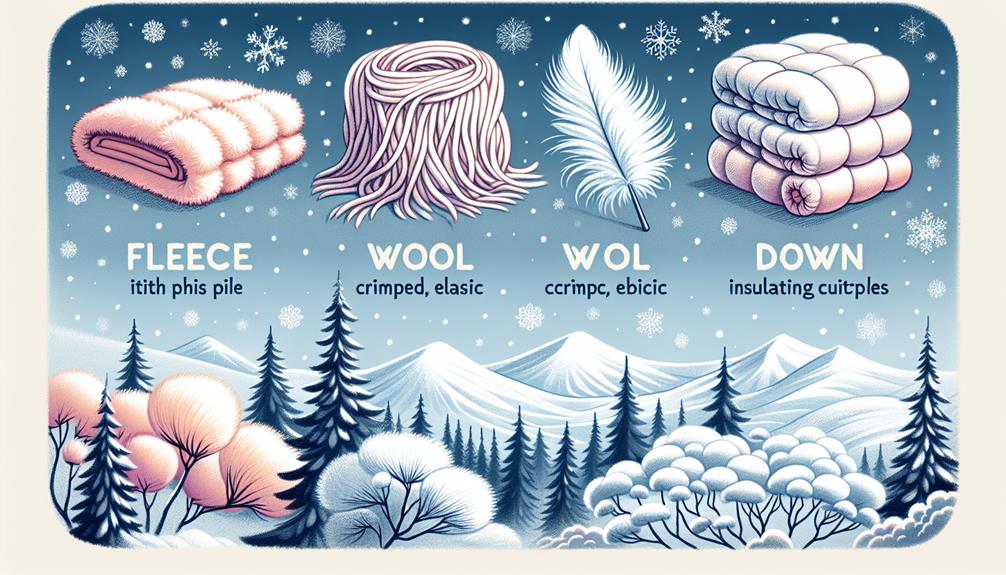When pondering what fabric provides the paramount warmth, the answer lies in the fibers we choose to don. Wool, known for its natural insulating properties, stands stalwart in the domain of warmth.
Yet, in the labyrinth of textiles, fleece, down, cashmere, and even synthetic fabrics vie for the title of the warmest. So, which fabric truly reigns supreme in the quest for cozy comfort?
Let's unravel this fabric mystery together.
Table of Contents
Key Takeaways
- Cashmere offers luxurious warmth with exceptional heat retention and elegant draping, perfect for various occasions.
- Down fabric provides lightweight warmth, excellent heat retention, breathability, and versatility for different garments.
- Fleece fabric combines softness, warmth, quick-drying properties, and easy care for comfortable and functional winter wear.
- Wool fabric stands out for its natural insulating properties, temperature regulation, durability, and resistance to wrinkles, ensuring warmth and comfort.
Wool: Nature's Insulator
Wool naturally preserves warmth due to its unique insulating properties, making it an ideal choice for combating chilly weather. One of the key benefits of wool is its ability to trap air within its fibers, creating a natural barrier against the cold. This insulation works by preventing heat loss from the body, keeping you warm and cozy even in the coldest of conditions.
Moreover, wool has the remarkable quality of being able to regulate body temperature. It can effectively wick moisture away from the skin while still retaining its insulating properties when wet. This means that even if you work up a sweat, wool will continue to keep you warm and dry.
In addition, wool is a durable and long-lasting material, making it a wise investment for winter wear. Its natural elasticity allows it to retain its shape and resist wrinkles, ensuring that your wool garments will maintain their insulating properties for years to come.
Fleece: Soft and Snug
When it comes to cozy comfort and warmth, fleece emerges as a top contender for its soft and snug qualities. Fleece is renowned for its exceptional softness, providing a luxurious feel against the skin. This fabric is a favorite choice for many due to its plush texture that keeps you warm and snug during colder seasons. Despite its softness, fleece is also highly durable, making it a practical option for everyday wear.
Regarding warmth, fleece holds its own against wool. While wool is known for its insulating properties, fleece provides a comparable level of warmth without the itchiness that some may experience with wool garments. Fleece is often lighter in weight than wool, making it a versatile choice for layering in varying weather conditions. Additionally, fleece is easy to care for, as it's machine washable and dries quickly, further enhancing its appeal for those seeking a low-maintenance yet cozy option for staying warm.
Down: Lightweight and Warm
Lightweight and incredibly warm, down is a popular choice for those seeking cozy insulation without added bulk. When it comes to staying warm without feeling weighed down, down fabric is a top contender. Here are some key points to ponder about this lightweight insulation and its natural warmth:
- Excellent Heat Retention: Down traps warm air effectively, keeping you snug in cold weather.
- Breathable: Allows moisture to escape, preventing overheating during activities.
- Packable: Easy to compress and pack, making it ideal for travel or outdoor adventures.
- Durable: With proper care, down garments can last for many years.
- Versatile: Can be used in a variety of garments, from jackets to sleeping bags, providing warmth in various settings.
Choosing down for its lightweight insulation and natural warmth can greatly enhance your cold-weather wardrobe, ensuring you stay cozy and comfortable without sacrificing mobility or style.
Cashmere: Luxurious Heat
Soft to the touch and exuding luxurious warmth, cashmere is a premium fabric renowned for its exceptional heat-retaining properties. When it comes to luxurious comfort and cozy warmth, cashmere stands out as a top choice. The fine fibers from cashmere goats create a fabric that's incredibly soft and provides remarkable insulation, making it ideal for cold weather.
Not only does cashmere offer unparalleled warmth, but it also drapes elegantly, adding a touch of sophistication to any outfit. The luxurious feel of cashmere against the skin is unmatched, making it a favorite among those who appreciate quality and style.
Whether you opt for a cashmere sweater, scarf, or blanket, you can be sure that you're choosing a fabric that will keep you snug and stylish. The natural breathability of cashmere allows for comfort without overheating, making it a versatile option for various occasions. Embrace the luxurious heat of cashmere for a cozy and chic addition to your wardrobe.
Synthetic Fabrics: Tech Warmth
I can't wait to share with you the incredible benefits of tech fabrics when it comes to keeping warm in cold weather.
These synthetic materials are designed to provide exceptional performance and insulation, making them a top choice for staying cozy in chilly conditions.
Let's explore how tech warmth can revolutionize the way we dress for the cold!
Tech Fabric Benefits
When it comes to staying warm in outdoor activities, synthetic fabrics offer advanced technology that provides exceptional insulation without the bulkiness. Synthetic fabrics have numerous benefits that make them ideal for cold weather adventures:
- Moisture wicking capabilities: Synthetic fabrics are excellent at pulling moisture away from the skin, keeping you dry and comfortable.
- Thermal regulation: These fabrics help regulate body temperature by trapping heat close to the body when it's cold.
- Breathable construction: They allow for better airflow, preventing overheating during intense activities.
- Temperature control: Synthetic fabrics adapt to your body temperature, providing warmth when needed and cooling when it gets too hot.
- Durability: These fabrics are tough and can withstand harsh outdoor conditions, ensuring longevity in your gear.
Performance in Cold
In cold weather conditions, synthetic fabrics with advanced technology excel at providing exceptional warmth and insulation for outdoor activities. When it comes to thermal performance and cold weather comfort, these fabrics stand out. The innovative design of synthetic materials guarantees that body heat is retained, keeping you warm and cozy even in the harshest conditions. Here is a comparison of how these synthetic fabrics fare regarding thermal performance and cold weather comfort:
| Fabric | Thermal Performance | Cold Weather Comfort |
|---|---|---|
| Polyester | High | Excellent |
| Nylon | Great | Very Good |
| Polypropylene | Superior | Outstanding |
Choosing the right synthetic fabric can make a significant difference in how comfortable and warm you stay during your outdoor adventures.
Silk: Surprisingly Warm
I never realized how warm silk could be until I tried it myself.
Its insulating properties are truly remarkable, especially when compared to other fabrics.
Using silk during winter might just be the cozy secret we've all been missing out on.
Silk's Insulating Properties
Surprisingly warm, silk's insulating properties can rival those of traditional winter fabrics. Silk's breathability and thermal properties make it a standout choice for staying cozy in colder climates. Here are some key points to take into account:
- Natural Insulation: Silk traps body heat close to the skin, creating a warm microclimate.
- Regulates Temperature: Silk helps regulate body temperature by keeping you warm in the cold and cool in the heat.
- Lightweight Comfort: Despite its warmth, silk is incredibly lightweight, offering comfort without bulk.
- Moisture Wicking: Silk's moisture-wicking properties keep you dry by absorbing perspiration.
- Luxurious Feel: In addition to its insulating properties, silk feels luxurious against the skin, adding a touch of elegance to your winter wardrobe.
Silk Vs Other Fabrics
Comparing silk to other fabrics regarding warmth reveals its surprising insulating capabilities. Silk's benefits extend beyond its luxurious feel; it's remarkably warm due to its natural properties.
Unlike many fabrics, silk is lightweight yet traps heat effectively, making it an excellent choice for winter wear. The tightly woven fibers of silk create pockets of air that retain body heat, providing insulation without bulk. This unique feature sets silk apart from other materials like cotton or polyester, which may not offer the same level of warmth.
When considering the warmth-to-weight ratio, silk emerges as a top contender for keeping you cozy in cold weather. Embracing silk for its insulating properties is a wise decision for those seeking both comfort and warmth.
Silk for Winter
When it comes to staying warm during winter, silk stands out as a surprisingly effective choice due to its exceptional insulating properties. Silk offers numerous advantages for winter wear, making it a luxurious yet practical option:
- Natural Insulation: Silk fibers trap air close to the skin, providing warmth.
- Lightweight: Despite its warmth, silk is lightweight and comfortable to wear.
- Moisture-wicking: Silk helps regulate body temperature by wicking away moisture.
- Softness: Silk's smooth texture feels gentle against the skin, ideal for layering.
- Versatility: Silk garments can be dressed up or down, adding a touch of winter elegance to any outfit.
Flannel: Winter Comfort
Flannel wraps around me like a cozy hug on a chilly winter day. Its softness is unmatched, making it the perfect choice for winter layers or cozy pajamas. When the temperature drops, flannel is my go-to fabric for staying warm and comfortable.
What sets flannel apart is its unique ability to trap heat close to the body, creating a snug barrier against the cold. Whether I'm lounging at home or braving the outdoors, flannel keeps me feeling toasty and relaxed. The brushed surface of flannel not only feels incredibly gentle against my skin but also helps retain body heat, making it an ideal winter fabric.
I love how versatile flannel is. It's perfect for pajamas that keep me warm through the night, or as a cozy layer under a winter jacket when I head out. Flannel isn't just a fabric; it's a winter essential that combines comfort and warmth effortlessly.
Frequently Asked Questions
Are There Any Specific Care Instructions for Maintaining the Warmth and Quality of These Fabrics?
To maintain warmth and quality of fabrics, follow care instructions diligently. Use gentle washing techniques to preserve durability. Avoid harsh chemicals and excessive heat. Proper maintenance tips enhance longevity and keep fabrics in top condition.
Can These Fabrics Be Used in Different Climates or Are They Specifically Suited for Cold Weather?
I find that these fabrics offer great climate versatility, making them suitable for various seasons. Their adaptability allows me to use them comfortably in different climates, not just cold weather. It's quite convenient!
Are There Any Sustainable or Eco-Friendly Options Available for These Warm Fabrics?
When it comes to sustainable options, I look for fabrics with eco-friendly choices that also provide excellent insulation. Understanding the thermal properties of these materials helps me make informed decisions for a cozy and eco-conscious wardrobe.
How Do These Fabrics Compare in Terms of Breathability and Moisture-Wicking Properties?
Breathability comparison among fabrics varies based on their composition. Some fabrics excel in moisture-wicking performance, keeping me cool and dry, while others may feel more stifling. Understanding these properties helps me choose the best fabric for different activities.
Are There Any Specific Brands or Manufacturers Known for Producing High-Quality, Warm Fabrics?
When it comes to high quality and innovative fabric technologies, luxury brands like Patagonia, The North Face, and Arc'teryx are known for producing excellent warm fabrics. Their dedication to quality and performance sets them apart.
- Why Is Red Velvet Not Red? - April 25, 2024
- How Do You Describe Velvet Fabric? - April 25, 2024
- How Strong Is Velvet? - April 25, 2024





